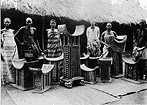 In many African societies, stools and chairs were significant objects of leadership regalia. A British naval officer visiting King Gezo of Dahomey in the 1850s reported that the king's viceroy was "preceded by about 40 soldiers armed with muskets; next came his stool of office and two banners." Typically, these stools were richly ornamented in silver, ivory and other rare, precious and expensive materials to emphasize the ruler's power and authority. It was said a king without his chair was without his dignity.
In many African societies, stools and chairs were significant objects of leadership regalia. A British naval officer visiting King Gezo of Dahomey in the 1850s reported that the king's viceroy was "preceded by about 40 soldiers armed with muskets; next came his stool of office and two banners." Typically, these stools were richly ornamented in silver, ivory and other rare, precious and expensive materials to emphasize the ruler's power and authority. It was said a king without his chair was without his dignity.
The Asante nation regards a stool as a highly personal object that is believed to embody one's soul. The king's stool is especially revered because the king represents the nation's soul. Indeed, the stool is so significant the Asante believe the Golden Stool was sent down from heaven during the reign of Osei Tutu (c. 1701) to house the soul of the Asante peoples. No one, not even the king, was allowed to sit on it. The stools of all subsequent kings are, upon their deaths, preserved in commemoration and as a resting place for their souls.
African artists most often carve stools from one block of wood. The stools tend to be of two types: a rectangular or square block with a deeply curved seat and a cylindrical form shaped like a spool or reel. Stools of the Asante and the Fon typically conform to the first type, although the enthronement stools (keteke) of the kings of Dahomey are a simple three-legged stool with a round seat (see The Art of the Personal Object, Level 1). The second, cylindrical type appears mostly in Nigeria, Cameroon, Democratic Republic of the Congo, Republic of the Congo and Zambia.
Among the first to recognize the aesthetic dimension of African furnishings was art historian Roy Sieber who suggested that some African ceremonial furniture displays the influence of European styles. The elbow chair (one with armrests) was brought to the Gold Coast by the Portuguese as early as 1481. In 1793 a French explorer named Dalzel brought the king of Dahomey a "very handsome sedan chair" as a gift. King Glele's royal throne, seized by the French after the defeat of King Behanzin in 1894, contained carvings that combined local and European motifs--palmettes, shells and scrolls. Thus, with the furniture of Pierre Legrain, the circle of inspiration and influence comes full circle.